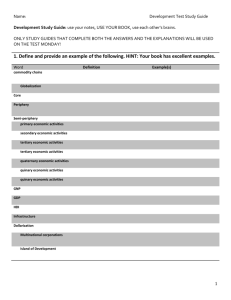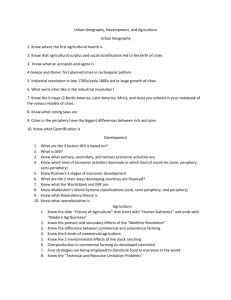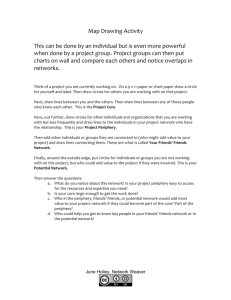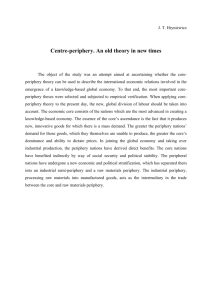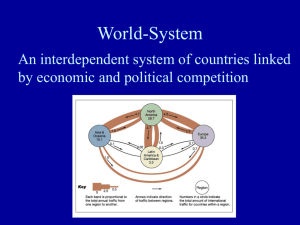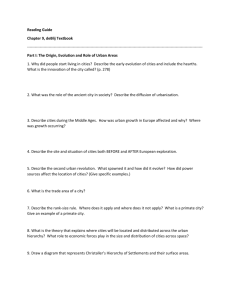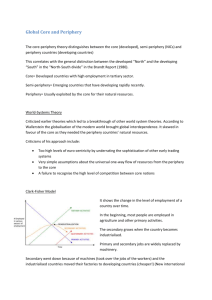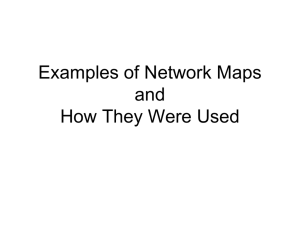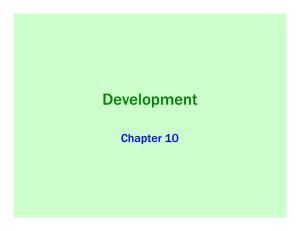Alternative Views of Development
advertisement
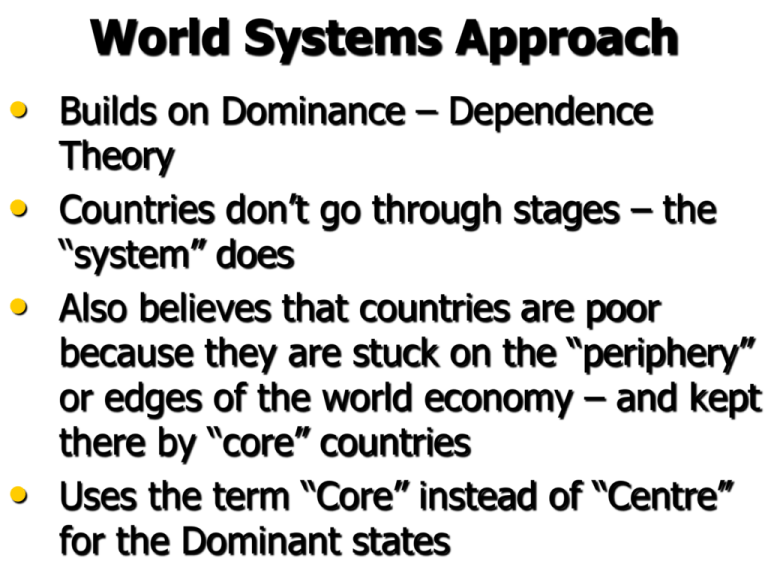
World Systems Approach • Builds on Dominance – Dependence Theory • Countries don’t go through stages – the “system” does • Also believes that countries are poor because they are stuck on the “periphery” or edges of the world economy – and kept there by “core” countries • Uses the term “Core” instead of “Centre” for the Dominant states World Systems Approach • Late 18th / early 19th centuries marked a turning point in capitalism – capitalists achieved power in key countries which furthered the industrial revolution (eg Britain). • Believes there are three types of countries 1. Core = Centre / Dominant 2. Semi-periphery = Cores on the way “down”, or Peripheries on the way “up”! 3. Periphery = Dependent World Systems Approach 1. Core countries: • The most economically diversified, wealthy, and powerful (economically and militarily) • Have strong central governments, controlling extensive bureaucracies and powerful militaries • Have more complex and stronger state institutions that help manage economic affairs internally and externally • Have a sufficient tax base so these state institutions can provide infrastructure for a strong economy World Systems Approach 1. Core countries: • Highly industrialized; produce manufactured goods • • • • • rather than raw materials for export Increasingly tend to specialize in information, finance and service industries More often in the forefront of new technologies and new industries. Examples today include hightechnology electronic and biotechnology industries. Another example would be assembly-line auto production in the early twentieth century. Has strong bourgeois and working classes Have significant means of influence over noncore nations Relatively independent of outside control World Systems Approach 1. Core countries: gain • Access to a large quantity of raw • • • • material Cheap labour Enormous profits from direct capital investments A market for exports Skilled professional labour through migration of these people from the periphery to the core. World Systems Approach 1. Core countries: • Sometimes one core country or region will become a “hegemon” or “supercore” • Portugal / Spain in the 16th century • North-West Europe (France, Holland, Britain) in the 18th / 19th centuries • USA in the 20th century World Systems Approach 2. Semi-periphery countries: • Part way between the core and periphery. • Usually countries moving towards industrialization and a more diversified economy • But can come from declining cores. World Systems Approach 2. Semi-periphery countries: • They may be dominated by core countries, but may also partially dominate periphery countries • Spain and Portugal: - fell from their early core position, but still manage to retain influence in Latin America. They imported silver and gold from their colonies, but then had to use it to pay for manufactured goods from core countries such as England and France. World Systems Approach 3. Periphery countries: • Least economically diversified • Relatively weak governments • Relatively weak institutions with little • • tax base to support infrastructure development Depend on one type of economic activity, often on extracting and exporting raw materials to core nations, cash crops etc Least industrialized World Systems Approach 3. Periphery countries: • Targets for investments from • • • multinational corporations. Come into the country to exploit cheap unskilled labour for export back to core nations Small bourgeois and large peasant classes High percentage of people poor and uneducated. Inequality very high - a small upper class (elite) owns most of the land and has profitable ties to multinational corporations World Systems Approach 3. Periphery countries: • Extensively influenced by core nations and their multinational corporations. Many times they are forced to follow economic policies that favour core nations and harm the long-term economic prospects of periphery nations. • Historically, peripheries were found outside Europe, for example in Latin America, Asia, Africa. World History According to the World Systems Approach • 15th century – Spain and Portugal lead the way but overextended themselves with empire building • Gained huge wealth from colonies but fell behind in industrial production • 17th century – Holland with its new financial system based on global capitalism (which others copied eg Britain) • Holland also had many colonies eg East Indies • As the Dutch economy grew and standard of living rose its costs of production went up! Began to invest overseas eg British industry World History According to the World Systems Approach • 19th century – Britain became the “hegemon” • Highly industrialised, capitalism thriving • Massive growth in colonisation eg NZ • This cost a lot of money so their clear dominance ended • By 1900 the old European “core” claimed 85% of the world’s territory! • The only way to gain land was through war against other “core” nations – eg Germany, Japan, Italy • A truly “global economy” emerging World History According to the World Systems Approach • Post World War 1 – the “American Century” – USA a “hegemon” • Rapid industrialisation after the 1860’s Civil War, helped by investment from Britain, Holland • After World War 2 the USA had over ½ the world’s industrial production, 2/3 of gold reserves, 1/3 of world’s exports • Since the 1990’s USA “hegemony” has been eroding. World History According to the World Systems Approach • The “core” is now Europe + USA + Japan • Others approaching eg South Korea, China • Semi – periphery = states that have been long independent but have not yet reached Western levels of influence eg Brazil, India? NZ and Australia? • Periphery = poor former Western colonies eg Southeast Asia, Africa Major Critics (1)The above discussion has shown that both world- system and dependency theorists, while somewhat different from each other, share the same methodology – “looking outward” and attributing underdevelopment to its external relations in the world market and international system that are governed by the interests of dominant nations and of certain classes and groups in them. However, both dependency and world-system theorists overlook the impact of the internal constraints of the underdeveloped countries -- the economic, political, social, and cultural characteristics and structures of these countries -- upon the development of the underdeveloped areas and countries. Major Critics (2) For the policy implications under this category, breaking-up of the old system is seen as necessary before the establishment of “an equalitarian world-system;” in the meanwhile, the periphery states should cooperate to offset the power of the core. However, this involves them in a problematic relation with the global economic dynamics that underlies the change of the world-system and the possibilities in the direction of development at every occurrence of upward and Who is right? Three theories have provided three solutions to the Third World development: - Increase of modernity - Independence and de-linking from the world economy - Reform of the world system Q: Which side do you think has more power for explaining the Third World development in the last several decades?
